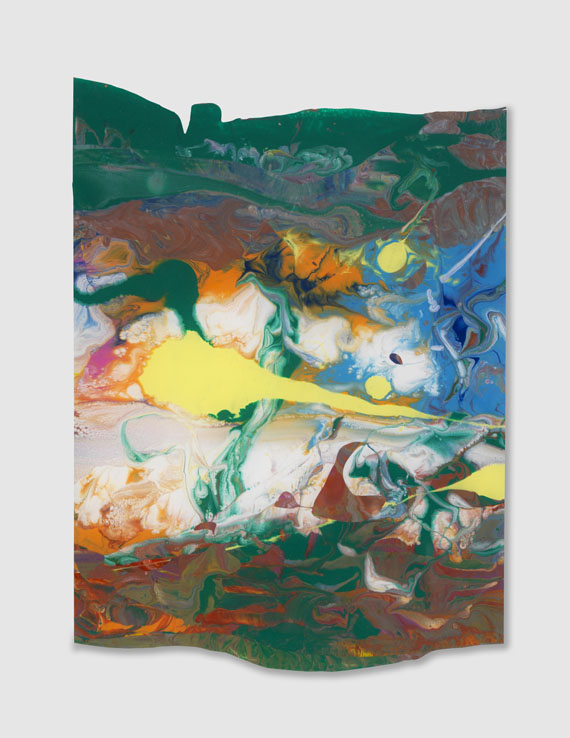Frame image
236
Gerhard Richter
Abdallah, 2010.
Acrylic lacquer behind glass
Estimate:
€ 50,000 / $ 56,500 Sold:
€ 81,250 / $ 91,812 (incl. surcharge)
Abdallah. 2010.
Acrylic lacquer behind glass.
Online catalog raisonné of paintings 917-59. Verso signed and dated as well inscribed with the work number "917-59". Unique object. 33 x 33 cm (12.9 x 12.9 in), incl. frame.
• Richter's reverse glass paintings are marvelous documents of his technical mastery and innovative power.
• In terms of their variety, Richter's glass works stand for his joy in experimenting.
• In a fascinating balance of plan and chance, Richter creates impressive color structures on the smooth surface of the image carrier.
• With reverse glass compositions based on very strict selection processes, and names from the Middle Eastern fairytales of "1001 Nights", Richter opens up vast spaces for associations.
PROVENANCE: Galerie Fred Jahn, Munich.
Private collection Hesse (acquired from the above).
LITERATURE: Gerhard Richter, Marian Goodman Gallery, London 2014, p. 7.
Gerhard Richter: Streifen & Glas, Staatliche Kunstsammlungen Dresden / Kunstmuseum Winterthur, Cologne 2013, p. 31.
"I am fascinated by chance, as almost everything is chance. The way we are, why I wasn't born in Africa but here. It's all chance."
Gerhard Richter, November 2016.
Acrylic lacquer behind glass.
Online catalog raisonné of paintings 917-59. Verso signed and dated as well inscribed with the work number "917-59". Unique object. 33 x 33 cm (12.9 x 12.9 in), incl. frame.
• Richter's reverse glass paintings are marvelous documents of his technical mastery and innovative power.
• In terms of their variety, Richter's glass works stand for his joy in experimenting.
• In a fascinating balance of plan and chance, Richter creates impressive color structures on the smooth surface of the image carrier.
• With reverse glass compositions based on very strict selection processes, and names from the Middle Eastern fairytales of "1001 Nights", Richter opens up vast spaces for associations.
PROVENANCE: Galerie Fred Jahn, Munich.
Private collection Hesse (acquired from the above).
LITERATURE: Gerhard Richter, Marian Goodman Gallery, London 2014, p. 7.
Gerhard Richter: Streifen & Glas, Staatliche Kunstsammlungen Dresden / Kunstmuseum Winterthur, Cologne 2013, p. 31.
"I am fascinated by chance, as almost everything is chance. The way we are, why I wasn't born in Africa but here. It's all chance."
Gerhard Richter, November 2016.
After a few experimental attempts, Richter began to discover the technique of reverse glass painting in 2008 and to use it for his paintings of controlled chance. The series of paintings "Sindbad" (2008), "Aladin", "Baghdad", "Ifrit", "Perizade" and "Abdallah" (each 2010) are created, all of whose titles have their origins in the rich culture of the Orient. Richter borrowed these titles from the figures of Islamic mythology and the famous collection of fairy tales "1001 Nights", which was translated from Middle Persian into Arabic in Baghdad around the year 800 and from then on became widespread in oriental and later also in occidental culture. It is certainly no coincidence that Richter placed this thematic world of the flourishing West alongside his abstract creations at a time when the Orient was being marked by war and the devastation of the Iraq war. Gerhard Richter is not only a master of painterly experimentation in the field of tension between calculation and chance, but also a master of playing with free association. Richter's oriental titles give the viewer space to associate the bright, abstract color gradients with the bright colors of the Orient or their finely structured movement, fixed behind glass, with the formal repertoire of Arabic calligraphy. And finally, an association with the uncontrolled chaos of the destruction of war cannot be ruled out. Richter declares the luminous, abstract color structures, which are the result of his masterly staging of calculated coincidence, to be the protagonists of his composition, which is placed on the back of the picture carrier and is therefore fascinatingly enraptured. For this impressive result, Richter first lets the paint flow onto a Plexiglas support and only partially intervenes in this accidental process of image formation through the use of brushes, chopsticks and spatulas. Finally, Richter transfers the desired section of the resulting composition to the glass plate using a perfected copying process, which ultimately permanently preserves these marbled color structures. [JS]
236
Gerhard Richter
Abdallah, 2010.
Acrylic lacquer behind glass
Estimate:
€ 50,000 / $ 56,500 Sold:
€ 81,250 / $ 91,812 (incl. surcharge)
Headquarters
Joseph-Wild-Str. 18
81829 Munich
Phone: +49 89 55 244-0
Fax: +49 89 55 244-177
info@kettererkunst.de
Louisa von Saucken / Undine Schleifer
Holstenwall 5
20355 Hamburg
Phone: +49 40 37 49 61-0
Fax: +49 40 37 49 61-66
infohamburg@kettererkunst.de
Dr. Simone Wiechers / Nane Schlage
Fasanenstr. 70
10719 Berlin
Phone: +49 30 88 67 53-63
Fax: +49 30 88 67 56-43
infoberlin@kettererkunst.de
Cordula Lichtenberg
Gertrudenstraße 24-28
50667 Cologne
Phone: +49 221 510 908-15
infokoeln@kettererkunst.de
Hessen
Rhineland-Palatinate
Miriam Heß
Phone: +49 62 21 58 80-038
Fax: +49 62 21 58 80-595
infoheidelberg@kettererkunst.de
We will inform you in time.




 Lot 236
Lot 236 
